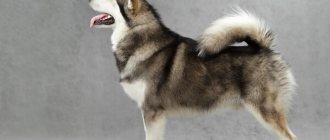The Labrador and the Golden Retriever have earned worldwide fame. They became famous as wonderful nannies, companions and service dogs. They are often kept as family dogs. However, before choosing a puppy, you need to understand which breed is closer in spirit. Labrador and retriever: what is the difference, let's look at it in more detail.
Labrador
The history of the breed dates back to the 19th century. It is believed that the ancestors of modern Labradors were the so-called “little Newfoundlands.”
It was these dogs that were brought to Great Britain, where, as a result of their crossing with curly-coated retrievers and, probably, English foxhounds and setters, Labradors were bred.
Description
Labradors are well-built dogs with regular proportions, a large head, a broad chest and powerful limbs.
Despite the good-natured and attentive look of representatives of this breed, their restrained strength and willingness to act cannot go unnoticed.
The average life expectancy of Labradors with proper care and suitable living conditions is 12-14 years.
Adults grow to 54-57 cm at the withers and weigh 27-40 kg.
The breed standard
allows for minor deviations in growth.
Exterior
Description of the exterior in accordance with the FCI system :
- the body is slightly stretched, the back line is straight, the lower back is strong and wide;
- chest of moderate depth, rounded ribs;
- the skull is moderately wide, there are no rough lines, the transition from the forehead to the non-pointed muzzle is clearly defined;
- jaws are well developed, scissor bite;
- the limbs are straight, the shoulders are long and oblique, the paws are arched;
- eyes are medium-sized, hazel or brown;
- ears are hanging, medium size, set far apart;
- the undercoat is waterproof, well developed;
- The outer hair is dense and coarse, without waves or fringes.
The coat color can be deep brown, light or black.
For dogs of fawn and chocolate color, brown pigmentation of the nose is allowed .
Character
Labradors are good-natured and playful dogs. Their optimism and cheerful attitude help create an atmosphere of happiness, calm and harmony in the family.
Almost constantly being in a good mood, Labradors are not characterized by despondency and passivity . These are active dogs that enjoy playing with their owner or on their own.
At the same time, they absolutely cannot stand loneliness and need constant communication and attention.
Labradors are smart and quick-witted animals that are easy to educate and train. Moreover, they themselves love it when their owner works with them and try with all their might to please him, accurately following all commands.
Table
The main features of dogs are shown in the table:
| Criterion | Labrador | Retriever |
| Color | Black, fawn, brown | Golden |
| Lifespan | 13-14 years old | 11-12 years old |
| Physical Features | Straight, wide tail, webbed feet, folded ears | Straight shaggy tail, webbed feet, folded ears |
| Character | Playful, kind, pleasant, sporty | Calm, welcoming, friendly, patient |
Golden retriever
For a long time, it was believed that golden retrievers owe their appearance to the Scottish Lord Tweedmouth, who claimed that Russian shepherd dogs he acquired at one of the circus performances in 1858 were used in breeding the breed.
However, in the 20th century. it became known that Tweedmouth bought a golden puppy and crossed it with a spaniel, resulting in golden puppies .
Bloodhounds, black retrievers and Irish setters were also used to develop the breed.
Description
Strong bones, harmonious and symmetrical physique, confident movements and an attentive, friendly look - this is what catches your eye when you see golden retrievers.
Representatives of this breed live on average 10-12 years.
The height of adult individuals at the withers is 51-61 cm, and weight is 25-41 kg.
The breed standard does not have clear regulations regarding the body weight of Golden Retrievers.
Exterior
Breed standard:
- the head is proportional to the body;
- the skull is slightly convex, wide, with a clear transition from the forehead to the muzzle;
- the muzzle is straight and long;
- ears are rounded at the ends, hanging, set at eye level;
- jaws are strong, scissor bite;
- dark brown eyes with the same rim;
- neck with developed muscles, medium in length;
- the legs are powerful, muscular, the length of the shoulder blades is equal to the length of the shoulders, the elbows are adjacent to the body, the shoulder blades are laid back;
- The coat is straight, smooth or wavy, the undercoat is dense.
The standard allows any coat color, except dark red and mahogany.
Character
Golden retrievers are not known for their aggressive behavior. They are friendly to everyone without exception, adore their owners and strive to spend as much time as possible with them. These dogs are extremely difficult to tolerate separation and loneliness.
CAREFULLY!
If the dog is required to perform guard and security functions, then golden retrievers are not the best choice.
Representatives of this breed will notify about the appearance of strangers with a loud bark, but at the same time they will prefer to make friends with them than to defend their owners.
Goldens are distinguished by a high level of energy and a love of active, active games. They love water and enjoy participating in water activities, satisfying their hunting instincts.
Due to their high intelligence, retrievers can be trained without problems . Today, these dogs are often used as guide dogs or therapy dogs.
Behavior and character of a handsome long-haired cat
The retriever is a hardy, fairly energetic dog. She has good instincts and excellent memory. A retriever dog exhibits its qualities both on land and in water, where it can search for (killed) game. Anyone who goes hunting with a dog believes that his best assistant is a retriever. Reviews of similar joint activities are confirmation. Indeed, they were originally bred to work in hunting. Now these dogs have successfully mastered many other specialties. Retrievers work at customs and participate in many rescue operations.
Representatives of the breed are good swimmers. They are also great with children. These dogs are highly trainable, but retriever training should take place in a calm atmosphere, without screaming or nervousness. These dogs catch everything on the fly. There is no need to raise your tone or use any serious punishment.
By nature, dogs are smart, affectionate, playful, kind and calm. They rarely bark, so they are not suitable for guard duty. Retrievers are not prone to dominance; they get along well with children. In many countries, these beauties are used as therapy dogs that brighten the lives of children with mental disorders, as well as those who live in shelters.
Retrievers make excellent therapy dogs due to their unique sensitivity and optimistic, gentle nature. If there are small children or elderly people in the family, then the golden retriever will become a friend and companion for them.
Such dogs are very delicate, they are not aggressive towards people (this behavior is not typical for them).
What are the differences?
There are several major differences between Labradors and Golden Retrievers related to their appearance and personality.
Coat type and what they look like in the photo
The coat of Labradors is covered with a specific waxy coating, characteristic of frequently swimming dogs. The guard coat is thick, elastic and dense, without curling or waviness.
Golden retrievers have a more decorative coat: it is shiny and slightly wavy . Beautiful feathering is clearly visible on the tail, neck, hips, and back of the forelimbs.
Body type
Labradors have a dense, muscular body and strong bones . They have a wide chest and back and a short loin, ears are slightly shorter and set higher, the head is larger, and the muzzle is less elongated.
The physique of goldens is more graceful. They have a longer neck, and some standards provide an angled transition to the tail.
The limbs of representatives of this breed are more proportional and better adapted to fast running..
Temperament and training
Both breeds are friendly, cheerful and lack aggression, but Labradors require a more active lifestyle and more exercise.
Both Labradors and Golden Retrievers respond well to training..
Minor problems may arise during training with Labradors - due to increased playfulness, representatives of this breed can be distracted, so you will need to show patience and restraint.
What are the similarities?
In addition to the fact that both breeds were bred for the purpose of hunting and their main task was to bring and serve game to the owner, these dogs have some other similarities:
- lack of qualities suitable for guard and military service;
- love of water games;
- high level of intelligence;
- good-natured character;
- ability to get along with other pets and children;
- endurance;
- subtle sense of smell;
- ability to learn.
They also have common exterior features, for example: wide heads proportional to the body, hanging ears, and a scissor bite.
The so-called “soft mouth” is another common feature of these breeds, bred specifically to avoid damage to game.
Photo
The differences, even in the photo, are visible to the naked eye and without explanation, you just need to place these breeds side by side:
Retriever
Labrador
Retriever puppy
Labrador puppies
Loyal companion dogs: 26 unique breeds
Which breed is best suited for indoors and outdoors?
The calm nature and lower need for exercise of retrievers make them more suitable for apartment living.
Labradors can also be kept in an apartment , but only if the pet is provided with constant mental and physical employment . These dogs need daily walks, active games, and repetition of learned commands.
Chaining is not acceptable for either Retrievers or Labradors.
Expert opinion
Kozhevin Semyon Kirillovich
Expert dog handler.
Of course, it is impossible to unambiguously describe absolutely all representatives of the breed - each animal is individual. At the same time, there are certain general characteristics inherent in the breed as a whole. Thus, Labradors are much more emotional than golden retrievers; they literally cannot control themselves when they are overwhelmed by emotions. They need active walks - their absence negatively affects the health and character of dogs. Goldens, although they love everything around them no less, behave more restrained and do not need physical exercise so badly.
Attitude towards children and pets
Both Labradors and Goldens are distinguished by their friendly nature and the ability to easily get along with absolutely everyone - they get along with other dogs, cats, and rodents without any problems. Problems with birds may arise, but they can be solved with the help of education.
Both breeds are characterized by a love for children, but it is important to understand that if we are talking about children under 10-12 years old, then it is better to choose a golden retriever.
These dogs are calmer and more balanced and will be able to tolerate more children's pranks.
Labradors, on the other hand, are more energetic and active dogs; they cannot always control their body and emotions, especially when expressing love.
Representatives of this breed will need a long training in self-control and the presence of children, otherwise, in a fit of emotion, the pet may accidentally push the child or grab his hand, which can frighten the baby.
Purpose of dogs
Retriever and Labrador differ not only in origin. Their special skills also speak volumes. For example, the Labrador is often called “the dog of the people.” This dog can do any kind of work (collecting caught fish, pulling a net or pulling a sled - an impossible task for such a worker still needs to be found).
As for the retriever, this type of dog is considered somewhat more sophisticated. He collects shot game. But his appearance alone indicates that the dog does not cope with physical labor very well. He is not as stocky as a Newfoundland dog with similar characteristics, and his range of physical abilities is therefore limited.
Similar article: First heat and rules for mating Labradors
Who is more picky about feeding?
Both Labradors and Golden Retrievers are practically omnivorous dogs. It is important to take this into account and prevent feeding your pets food from the common table and overfeeding - representatives of both breeds are prone to food allergies and obesity.
It is necessary to develop a feeding regimen and create a balanced diet and stick to them .
Legs
Golden Retrievers have more proportional limbs. They are better adapted to running than Labradors. This is due to the fact that the breed was originally bred as a hunting breed. Its representatives had to quickly run up to the shot game, covering considerable distances, and immediately return back.
At the same time, Labradors are largely considered a working breed. Fast and easy running cannot be considered a priority for them.
Other criteria
| Labrador | Golden retriever | |
| Shedding | Almost constantly | Maximum twice a year |
| Price | A puppy without documents and vaccinations can be bought for 5-15 thousand rubles, representatives of the breed class cost 20-35 thousand rubles, a show class puppy will cost 40-60 thousand rubles. and more | The cost of a pet class puppy starts from 25 thousand rubles, the average price of a show class puppy is 62 thousand rubles. |
| Tail | The tail is the so-called otter type - it is thickened at the base and covered with strong and short hair | Tail-feather decorated with a “suspension” |
Possible diseases
In general, representatives of both breeds are distinguished by good health, however, there are a number of diseases inherent in both Labradors and Golden Retrievers :
- volvulus;
- dysplasia of the hip and elbow joints;
- epilepsy;
- interdigital dermatitis;
- cataract;
- diabetes;
- osteochondrosis;
- atopy;
- food allergies;
- lymphoma;
- mastocytoma.
Golden Retrievers are also prone to developing raw eczema, hypothyroidism, lick granuloma, laryngeal paralysis, melanoma, aortic stenosis, glaucoma, progressive retinal atrophy, entropion and ectropion, distichiasis and von Willebrand disease.
IMPORTANT!
Labradors are often diagnosed with angiosarcoma, perianal fistula, lipoma, Addison's disease, histiocytoma, entropy, ectropion and myasthenia gravis.
The susceptibility to hereditary pathologies in Labradors is lower, since during the development of this breed there were practically no inbreedings.
One country - two stories
There are many differences between dogs of related breeds.
The history of the origin of both breeds dates back to Great Britain. It was there that work was carried out on crossing small Newfoundlands with similar breeds. Labradors were bred as companions, and the retriever was bred as a hunting dog.
There are other dog breeds that are similar to the Labrador. Most of them are also called “retriever”:
- curly-haired;
- golden;
- Nova Scotian;
- straight-haired;
- Chesapeake Bay Retriever;
- Labradoodle (a cross between a Labrador and a poodle);
- longhaired setter (Irish, English and Scottish).
Note! Labradors and dogs that look like them are one of the most popular breeds in the world. These affectionate, intelligent, friendly animals have captured people's hearts.
Differences are manifested in appearance and character
Who is better suited to a retriever, and who is a Labrador?
Labradors are more suitable for people leading an active, busy life. These are dogs for people with a strong, strong-willed character and self-confidence who can cope with the animal’s energy and direct it in the right direction.
If the dog is purchased for a family with small children or a calm person who prefers a measured lifestyle and leisurely walks, then it is better to opt for a Golden Retriever.
Let's sum it up
Both of these breeds have excellent qualities that are essential for rescue dogs, guide dogs, bloodhounds and hunters. However, Labradors have achieved the greatest success in saving people.
But retrievers are indispensable in canistherapy (treatment with dogs). Communication with this caring and attentive animal is necessary for children with various disabilities in mental, physical or psychological development.
We have presented to you two of the best (according to owners) representatives of dog breeds. All that remains is to decide which four-legged friend is more suitable for you - a Labrador or a retriever. What is the difference between them, you now already know, so choose a pet, taking into account the composition of your family and your own temperament.











